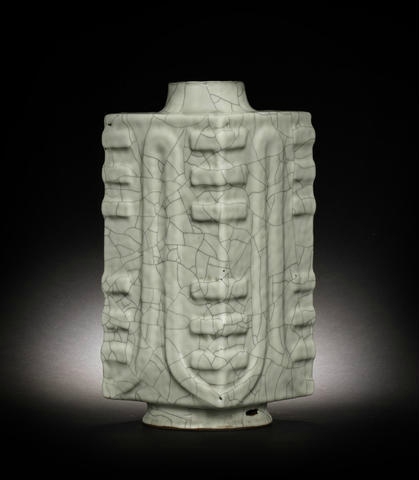A rare Ge-type vase, cong, Qianlong seal mark and of the period
Lot 28. A rare Ge-type vase, cong, Qianlong seal mark and of the period; 28.9cm (11 3/8in) high. Estimate £30,000 - 50,000 (€36,000 - 60,000). Unsold. Photo Bonhams.
Strongly potted after the archaic jade form, the straight sides rising from the short spreading circular foot pierced with two apertures, rising to the narrow tapering circular neck, the body moulded to each corner with the bagua, the 'Eight Daoist Trigrams' in two tiers framing in the centre of each side an undulating band, pierced to one side with two pairs of holes for suspension, covered overall with a soft crackled greyish glaze stopping at the foot ring to reveal the brown body.
The shape of this vase is based on Neolithic ritual jades, known particularly from the Liangzhu culture (3400 - 2250 BC). The form saw a revival during the Song Dynasty, when similarly shaped vessels were produced in Longquan celadon and in Guan type glazes; see for example in the National Palace Museum, Taipei, Porcelain of the National Palace Museum: Lung-Ch'uan Ware of the Sung Dynasty, Hong Kong, 1962, pl.12, p.50, Kuan Ware of the Sung Dynasty, pl.8a, p.33, and Kuan Ware of the Southern Sung Dynasty, Vol.I, pl.16, p.62. See also a related Guan-type glazed cong vase, Ming Dynasty, from the Qing Court Collection, illustrated in The Complete Collection of Treasures of the Palace Museum: Monochrome Porcelain, Hong Kong, 1999, pl.199.
Chang Li-tuan notes in The Refined Taste of the Emperor: Special Exhibition of Archaic and Pictorial Jades of the Ch'ing Court, National Palace Museum, Taipei, 1997, p.49 that the Qianlong Emperor proposed to 'restore ancient ways', suggesting that jade carvers turn to antiquity for models, enabling to imbue their designs with simplicity and honesty, achieving refinement and elegance. The 'ancient ways' referred to the intrinsic values of sincerity, simplicity, and happy exuberance. Similarly to jade, such inspiration was sought after and implemented in other mediums including porcelain made for the Imperial court. A Qianlong mark and period ge-type cong vase from the Imperial collections is illustrated in The Prime Cultural Relics Collected by Shenyang Imperial Palace Museum: The Chinaware Volume, The Second Part, Shenyang, p.164.
Vases such as the present lot are consequently highly sought after by collectors; see for example the vase illustrated by P.Lam, Ethereal Elegance: Porcelain Vases of the Imperial Qing: The Huaihaitang Collection, Hong Kong, 2007, no.45. Compare also a similar Ge-type glazed cong vase, Qianlong seal mark and period, sold at Christie's Hong Kong on 29 April 2002, lot 665. See also a related Ru-type glazed cong vase, Qianlong seal mark and period, sold at Sotheby's London on 6 November 2013, lot 154.
Bonhams. FINE CHINESE ART. London, New Bond Street, 15 May 2014 - www.bonhams.com

/https%3A%2F%2Fprofilepics.canalblog.com%2Fprofilepics%2F1%2F0%2F100183.jpg)
/https%3A%2F%2Fstorage.canalblog.com%2F03%2F02%2F119589%2F96711876_o.jpg)
/https%3A%2F%2Fstorage.canalblog.com%2F11%2F31%2F119589%2F94773502_o.jpg)
/https%3A%2F%2Fstorage.canalblog.com%2F20%2F83%2F119589%2F94772815_o.jpg)
/https%3A%2F%2Fstorage.canalblog.com%2F26%2F72%2F119589%2F75604929_o.jpg)
/https%3A%2F%2Fstorage.canalblog.com%2F59%2F60%2F119589%2F26458628_o.jpg)




/image%2F1371349%2F20240423%2Fob_af8bb4_telechargement-6.jpg)
/http%3A%2F%2Fstorage.canalblog.com%2F26%2F73%2F119589%2F129274410_o.jpg)
/http%3A%2F%2Fstorage.canalblog.com%2F22%2F94%2F119589%2F128094748_o.jpg)
/http%3A%2F%2Fstorage.canalblog.com%2F13%2F85%2F119589%2F128052038_o.jpg)